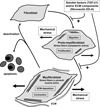The myofibroblast, multiple origins for major roles in normal and pathological tissue repair
- PMID: 23259712
- PMCID: PMC3368789
- DOI: 10.1186/1755-1536-5-S1-S5
The myofibroblast, multiple origins for major roles in normal and pathological tissue repair
Abstract
Myofibroblasts differentiate, invade and repair injured tissues by secreting and organizing the extracellular matrix and by developing contractile forces. When tissues are damaged, tissue homeostasis must be re-established, and repair mechanisms have to rapidly provide harmonious mechanical tissue organization, a process essentially supported by (myo)fibroblasts. Under physiological conditions, the secretory and contractile activities of myofibroblasts are terminated when the repair is complete (scar formation) but the functionality of the tissue is only rarely perfectly restored. At the end of the normal repair process, myofibroblasts disappear by apoptosis but in pathological situations, myofibroblasts likely remain leading to excessive scarring. Myofibroblasts originate from different precursor cells, the major contribution being from local recruitment of connective tissue fibroblasts. However, local mesenchymal stem cells, bone marrow-derived mesenchymal stem cells and cells derived from an epithelial-mesenchymal transition process, may represent alternative sources of myofibroblasts when local fibroblasts are not able to satisfy the requirement for these cells during repair. These diverse cell types probably contribute to the appearance of myofibroblast subpopulations which show specific biological properties and which are important to understand in order to develop new therapeutic strategies for treatment of fibrotic and scarring diseases.
Figures


References
-
- Hinz B, Darby IA, Gabbiani G, Desmoulière A. In: Tumor Associated Fibroblasts and their Matrix. Fusenig NE, Mueller MM, editor. New York: Springer; 2011. The role of the myofibroblast in fibrosis and cancer progression; pp. 37–74.
LinkOut - more resources
Full Text Sources
Medical

